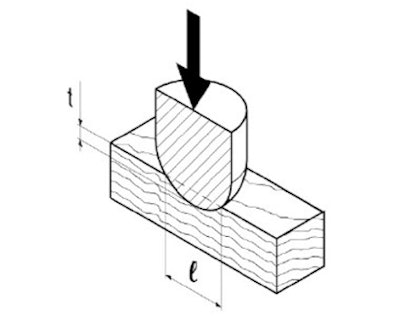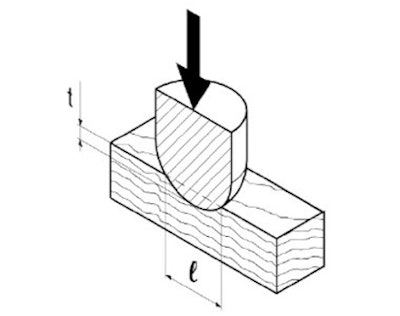
Scott Leavengood of OSU is back with more on wood hardness! I'm just going to turn this post right over to him to address a question received a few months back on "Monnin hardness" testing. However, first I do want to say that it sounds like the wood flooring industry needs to look into creating a meaningful test (or tests) specific to our industry. And that test should also reflect the various forms our product takes-solid, engineered with various cores and face veneer thicknesses, and of course, the type of finish we might apply… anyone have any suggestions? Feel free to post ideas.
In the meantime, Scott, the floor (so to speak) is yours:
We received a great question from a reader about Monnin hardness. As the reader said, don't the Brinell or Monnin hardness tests "…better replicate the abuse a floor takes from a high heel shoe?" Further, consumers want to know "…what damage is caused by constant pressure by the heel on the floor, not how much force is needed to cause a really bad dent."
First, let's talk about Monnin hardness. I must admit that I'd never heard of this test method. So I did a little research to learn more about it. Chapter 9 of the book Janka tests involved embedding a ball of 10 to a little over 11 mm into wood. With Monnin hardness, the test involves embedding a 30-mm cylinder with a maximum load of 2 kN (about 450 lbs.) over a period of 5 seconds. The figure below (from that same chapter in In Situ Assessment of Structural Timber) shows the test apparatus.

Since it's hard to measure the depth of the penetration (t), the width of the indentation (l) is measured instead and depth calculated from that. Monnin hardness is 1 over the depth of penetration.
And maybe you're thinking now what I thought when I read about this test method-it sounds a bit challenging to accurately measure the width, too! That's actually what the authors of the book chapter say: "Because it is not easy to measure accurately the width of the impression, the Monnin hardness is subject to greater experimental error than in the Janka test." Looking back at part 4 of this series, you might recall that the same situation exists for the Brinell test-measuring hardness with the Brinell test requires measuring the depth of penetration. This is really tough to do accurately!
So there's the bottom line, really. As the reader said, consumers want to know what damage is caused by constant pressure on a floor, such as by a heel vs. how much force is needed to cause the floor to dent (i.e., Janka hardness). And the Brinell and Monnin tests do seem to provide a better measure of hardness measured in terms of damage caused by constant pressure. So why is it then that most measures of hardness we see reported are from the Janka test vs. the other test methods? Well it seems the answer is due to two primary reasons:
- Janka hardness involves less experimental error
- It's an easier test to conduct.
In conclusion, we should mention that the test we now know as Janka has been modified from the original. Gabriel Janka's test was originally developed as a modified Brinell hardness test; he expressed the results as the load divided by the projected area of contact. However the ASTM test has always reported the results as the load at a penetration of 0.222 inches (i.e., half the depth of the ball).
Reference Sources:
Riggio, M., and M. Piazza. 2010. Chapter 9: Hardness Test. In: In Situ Assessment of Structural Timber. B. Kasal and T. Tanner (eds.).
Doyle, J. and J.C.F. Walker. 1985. Indentation Hardness of Wood. Wood and Fiber Science 17(3): 369-376.
































